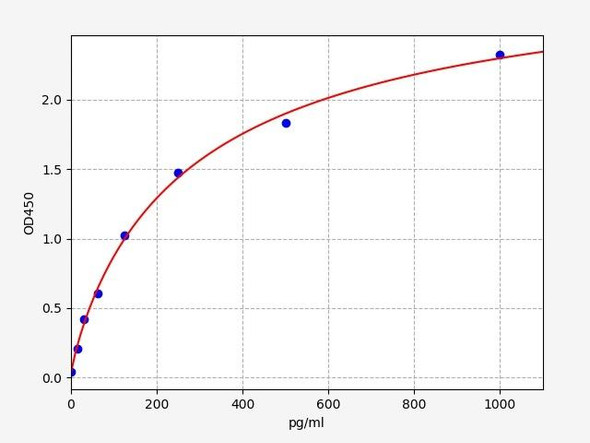Rat RAC-alpha serine/threonine-protein kinase (Akt1) ELISA Kit (RTEB0251)
- SKU:
- RTEB0251
- Product Type:
- ELISA Kit
- Size:
- 96 Assays
- Uniprot:
- P47196
- Range:
- 0.156-10 ng/ml
- ELISA Type:
- Sandwich
- Synonyms:
- Akt1, PKB alpha, PRKBA
- Reactivity:
- Rat
Description
Rat RAC-alpha serine/threonine-protein kinase (Akt1) ELISA Kit
The Rat Rac Alpha Serine-Threonine Protein Kinase Akt1 ELISA Kit is specifically designed for the precise measurement of Akt1 levels in rat samples, including serum, plasma, and cell culture supernatants. This kit boasts exceptional sensitivity and specificity, guaranteeing accurate and consistent results for various research endeavors.Akt1, also known as protein kinase B, is a key player in the regulation of cell growth, survival, and metabolism. It is implicated in various cellular processes, such as glucose metabolism, protein synthesis, and cell proliferation. Dysregulation of Akt1 signaling has been associated with numerous diseases, including cancer, diabetes, and cardiovascular disorders, making it a crucial target for therapeutic interventions.
With its advanced features and reliable performance, the Rat Rac Alpha Serine-Threonine Protein Kinase Akt1 ELISA Kit is an invaluable tool for scientists investigating the role of Akt1 in health and disease. Whether studying signal transduction pathways or exploring potential therapeutic strategies, this kit provides the precision and accuracy needed for successful research outcomes.
| Product Name: | Rat RAC-alpha serine/threonine-protein kinase (Akt1) ELISA Kit |
| SKU: | RTEB0251 |
| Size: | 96T |
| Target: | Rat RAC-alpha serine/threonine-protein kinase (Akt1) |
| Synonyms: | Protein kinase B, Protein kinase B alpha, RAC-PK-alpha, PKB, PKB alpha |
| Assay Type: | Sandwich |
| Detection Method: | ELISA |
| Reactivity: | Rat |
| Detection Range: | 0.156-10ng/ml |
| Sensitivity: | 0.078ng/mL |
| Intra CV: | 4.6% | ||||||||||||||||||||
| Inter CV: | 7.8% | ||||||||||||||||||||
| Linearity: |
| ||||||||||||||||||||
| Recovery: |
| ||||||||||||||||||||
| Function: | AKT1-specific substrates have been recently identified, including palladin (PALLD), which phosphorylation modulates cytoskeletal organization and cell motility; prohibitin (PHB), playing an important role in cell metabolism and proliferation; and CDKN1A, for which phosphorylation at 'Thr-145' induces its release from CDK2 and cytoplasmic relocalization. These recent findings indicate that the AKT1 isoform has a more specific role in cell motility and proliferation. Phosphorylates CLK2 thereby controlling cell survival to ionizing radiation. |
| Uniprot: | P47196 |
| Sample Type: | Serum, plasma, tissue homogenates, cell culture supernates and other biological fluids |
| Specificity: | Natural and recombinant rat RAC-alpha serine/threonine-protein kinase |
| Sub Unit: | Interacts (via the C-terminus) with CCDC88A (via its C-terminus). Interacts with GRB10; the interaction leads to GRB10 phosphorylation thus promoting YWHAE-binding. Interacts with AGAP2 (isoform 2/PIKE-A); the interaction occurs in the presence of guanine nucleotides. Interacts with AKTIP. Interacts (via PH domain) with MTCP1, TCL1A AND TCL1B. Interacts with CDKN1B; the interaction phosphorylates CDKN1B promoting 14-3-3 binding and cell-cycle progression. Interacts with MAP3K5 and TRAF6. Interacts with BAD, PPP2R5B, STK3 and STK4. Interacts (via PH domain) with SIRT1. Interacts with SRPK2 in a phosphorylation-dependent manner. Interacts with TNK2 and CLK2. Interacts with RAF1. Interacts (via the C-terminus) with THEM4 (via its C-terminus). Interacts with TRIM13; the interaction ubiquitinates AKT1 leading to its proteasomal degradation. Interacts with and phosphorylated by PDPK1 (By similarity). Interacts with BTBD10 (By similarity). Interacts with KCTD20 (By similarity). Interacts with PA2G4. Interacts with KIF14; the interaction is detected in the plasma membrane upon INS stimulation and promotes AKT1 phosphorylation (By similarity). Interacts with FAM83B; activates the PI3K/AKT signaling cascade (By similarity). Interacts with WDFY2 (via WD repeats 1-3) (By similarity). Forms a complex with WDFY2 and FOXO1 (By similarity). Interacts with FAM168A. |
| Research Area: | Cancer |
| Subcellular Location: | Cytoplasm Nucleus Cell membrane Nucleus after activation by integrin-linked protein kinase 1 (ILK1). Nuclear translocation is enhanced by interaction with TCL1A (By similarity). Phosphorylation on Tyr-176 by TNK2 results in its localization to the cell membrane where it is targeted for further phosphorylations on Thr-308 and Ser-473 leading to its activation and the activated form translocates to the nucleus. Colocalizes with WDFY2 in intracellular vesicles (By similarity). |
| Storage: | Please see kit components below for exact storage details |
| Note: | For research use only |
| UniProt Protein Function: | Akt1: an oncogenic AGC kinase that plays a critical role in regulating cell survival and metabolism in many different signaling pathways. Dual phosphorylation is required for its activation. T308 is phosphorylated by PDK1 in the PI3 kinase pathway, and S473 is phosphorylated by mTOR in the mTORC2 pathway. The 'Lys-63'-linked ubiquitination of AKT1 by TRAF6 is important for its translocation to the plasma membrane, phosphorylation, and activation. When Akt is fully phosphorylated it translocates into the nucleus, undergoes 'Lys-48'-polyubiquitination catalyzed by TTC3, leading to its proteosomal degradation. Hyperactive or overexpressed in a number of cancers including breast, prostate, lung, pancreatic, liver, ovarian and colorectal. Over 160 protein substrates are known including many that regulate transcription, metabolism, apoptosis, cell cycle, and growth. |
| UniProt Protein Details: | Protein type:EC 2.7.11.1; Protein kinase, Ser/Thr (non-receptor); Protein kinase, AGC; Oncoprotein; Kinase, protein; AGC group; AKT family Chromosomal Location of Human Ortholog: 14q32.32 Cellular Component: nucleoplasm; microtubule cytoskeleton; mitochondrion; cytoplasm; plasma membrane; spindle; intercellular junction; nucleus; cytosol Molecular Function:identical protein binding; protein serine/threonine kinase activity; protein binding; phosphatidylinositol-3,4,5-triphosphate binding; enzyme binding; protein kinase C binding; nitric-oxide synthase regulator activity; protein serine/threonine/tyrosine kinase activity; kinase activity; phosphatidylinositol-3,4-bisphosphate binding; ATP binding; protein kinase activity Biological Process: negative regulation of JNK cascade; positive regulation of nitric oxide biosynthetic process; regulation of myelination; nerve growth factor receptor signaling pathway; protein ubiquitination; glucose homeostasis; regulation of cell migration; protein amino acid phosphorylation; G1/S-specific positive regulation of cyclin-dependent protein kinase activity; germ cell development; positive regulation of glucose import; cell projection organization and biogenesis; protein catabolic process; maternal placenta development; response to food; platelet activation; glycogen biosynthetic process; fibroblast growth factor receptor signaling pathway; positive regulation of nitric-oxide synthase activity; positive regulation of blood vessel endothelial cell migration; glucose metabolic process; positive regulation of lipid biosynthetic process; positive regulation of cell growth; insulin-like growth factor receptor signaling pathway; cellular response to insulin stimulus; response to heat; T cell costimulation; positive regulation of fat cell differentiation; negative regulation of protein kinase activity; striated muscle cell differentiation; positive regulation of transcription from RNA polymerase II promoter; positive regulation of endothelial cell proliferation; positive regulation of transcription factor activity; response to oxidative stress; regulation of nitric-oxide synthase activity; negative regulation of apoptosis; negative regulation of autophagy; negative regulation of fatty acid beta-oxidation; translation; apoptosis; protein amino acid autophosphorylation; regulation of glycogen biosynthetic process; positive regulation of cellular protein metabolic process; positive regulation of glycogen biosynthetic process; negative regulation of cell size; negative regulation of caspase activity; glucose transport; signal transduction; nitric oxide metabolic process; regulation of translation; apoptotic mitochondrial changes; protein kinase B signaling cascade; inflammatory response; nitric oxide biosynthetic process; cell differentiation; activated T cell apoptosis; aging; negative regulation of proteolysis; epidermal growth factor receptor signaling pathway; phosphoinositide-mediated signaling; myelin maintenance in the peripheral nervous system; protein modification process; endocrine pancreas development; positive regulation of peptidyl-serine phosphorylation; osteoblast differentiation; cell proliferation; G-protein coupled receptor protein signaling pathway; peptidyl-serine phosphorylation; protein import into nucleus, translocation; positive regulation of proteasomal ubiquitin-dependent protein catabolic process; insulin receptor signaling pathway; positive regulation of vasoconstriction; innate immune response; gene expression; positive regulation of protein amino acid phosphorylation; blood coagulation; vascular endothelial growth factor receptor signaling pathway; phosphorylation; hyaluronan metabolic process Disease: Schizophrenia; Cowden Syndrome 6; Proteus Syndrome; Breast Cancer; Ovarian Cancer |
| NCBI Summary: | The serine-threonine protein kinase encoded by the AKT1 gene is catalytically inactive in serum-starved primary and immortalized fibroblasts. AKT1 and the related AKT2 are activated by platelet-derived growth factor. The activation is rapid and specific, and it is abrogated by mutations in the pleckstrin homology domain of AKT1. It was shown that the activation occurs through phosphatidylinositol 3-kinase. In the developing nervous system AKT is a critical mediator of growth factor-induced neuronal survival. Survival factors can suppress apoptosis in a transcription-independent manner by activating the serine/threonine kinase AKT1, which then phosphorylates and inactivates components of the apoptotic machinery. Mutations in this gene have been associated with the Proteus syndrome. Multiple alternatively spliced transcript variants have been found for this gene. [provided by RefSeq, Jul 2011] |
| UniProt Code: | P47196 |
| NCBI GenInfo Identifier: | 62241013 |
| NCBI Gene ID: | 207 |
| NCBI Accession: | NP_001014431.1 |
| UniProt Secondary Accession: | P47196,P31751, Q9Y243, P31750, Q60823, Q9WUA6, P47196 P47197, Q63484, |
| UniProt Related Accession: | P31749 |
| Molecular Weight: | 56kDa |
| NCBI Full Name: | RAC-alpha serine/threonine-protein kinase |
| NCBI Synonym Full Names: | AKT serine/threonine kinase 1 |
| NCBI Official Symbol: | AKT1 |
| NCBI Official Synonym Symbols: | AKT; PKB; RAC; CWS6; PRKBA; PKB-ALPHA; RAC-ALPHA |
| NCBI Protein Information: | RAC-alpha serine/threonine-protein kinase |
| UniProt Protein Name: | RAC-alpha serine/threonine-protein kinase |
| UniProt Synonym Protein Names: | Protein kinase B; PKB; Protein kinase B alpha; PKB alpha; Proto-oncogene c-Akt; RAC-PK-alpha |
| Protein Family: | AKT-interacting protein |
| UniProt Gene Name: | AKT1 |
| UniProt Entry Name: | AKT1_HUMAN |
| Component | Quantity (96 Assays) | Storage |
| ELISA Microplate (Dismountable) | 8×12 strips | -20°C |
| Lyophilized Standard | 2 | -20°C |
| Sample Diluent | 20ml | -20°C |
| Assay Diluent A | 10mL | -20°C |
| Assay Diluent B | 10mL | -20°C |
| Detection Reagent A | 120µL | -20°C |
| Detection Reagent B | 120µL | -20°C |
| Wash Buffer | 30mL | 4°C |
| Substrate | 10mL | 4°C |
| Stop Solution | 10mL | 4°C |
| Plate Sealer | 5 | - |
Other materials and equipment required:
- Microplate reader with 450 nm wavelength filter
- Multichannel Pipette, Pipette, microcentrifuge tubes and disposable pipette tips
- Incubator
- Deionized or distilled water
- Absorbent paper
- Buffer resevoir
*Note: The below protocol is a sample protocol. Protocols are specific to each batch/lot. For the correct instructions please follow the protocol included in your kit.
Allow all reagents to reach room temperature (Please do not dissolve the reagents at 37°C directly). All the reagents should be mixed thoroughly by gently swirling before pipetting. Avoid foaming. Keep appropriate numbers of strips for 1 experiment and remove extra strips from microtiter plate. Removed strips should be resealed and stored at -20°C until the kits expiry date. Prepare all reagents, working standards and samples as directed in the previous sections. Please predict the concentration before assaying. If values for these are not within the range of the standard curve, users must determine the optimal sample dilutions for their experiments. We recommend running all samples in duplicate.
| Step | |
| 1. | Add Sample: Add 100µL of Standard, Blank, or Sample per well. The blank well is added with Sample diluent. Solutions are added to the bottom of micro ELISA plate well, avoid inside wall touching and foaming as possible. Mix it gently. Cover the plate with sealer we provided. Incubate for 120 minutes at 37°C. |
| 2. | Remove the liquid from each well, don't wash. Add 100µL of Detection Reagent A working solution to each well. Cover with the Plate sealer. Gently tap the plate to ensure thorough mixing. Incubate for 1 hour at 37°C. Note: if Detection Reagent A appears cloudy warm to room temperature until solution is uniform. |
| 3. | Aspirate each well and wash, repeating the process three times. Wash by filling each well with Wash Buffer (approximately 400µL) (a squirt bottle, multi-channel pipette,manifold dispenser or automated washer are needed). Complete removal of liquid at each step is essential. After the last wash, completely remove remaining Wash Buffer by aspirating or decanting. Invert the plate and pat it against thick clean absorbent paper. |
| 4. | Add 100µL of Detection Reagent B working solution to each well. Cover with the Plate sealer. Incubate for 60 minutes at 37°C. |
| 5. | Repeat the wash process for five times as conducted in step 3. |
| 6. | Add 90µL of Substrate Solution to each well. Cover with a new Plate sealer and incubate for 10-20 minutes at 37°C. Protect the plate from light. The reaction time can be shortened or extended according to the actual color change, but this should not exceed more than 30 minutes. When apparent gradient appears in standard wells, user should terminatethe reaction. |
| 7. | Add 50µL of Stop Solution to each well. If color change does not appear uniform, gently tap the plate to ensure thorough mixing. |
| 8. | Determine the optical density (OD value) of each well at once, using a micro-plate reader set to 450 nm. User should open the micro-plate reader in advance, preheat the instrument, and set the testing parameters. |
| 9. | After experiment, store all reagents according to the specified storage temperature respectively until their expiry. |
When carrying out an ELISA assay it is important to prepare your samples in order to achieve the best possible results. Below we have a list of procedures for the preparation of samples for different sample types.
| Sample Type | Protocol |
| Serum | If using serum separator tubes, allow samples to clot for 30 minutes at room temperature. Centrifuge for 10 minutes at 1,000x g. Collect the serum fraction and assay promptly or aliquot and store the samples at -80°C. Avoid multiple freeze-thaw cycles. If serum separator tubes are not being used, allow samples to clot overnight at 2-8°C. Centrifuge for 10 minutes at 1,000x g. Remove serum and assay promptly or aliquot and store the samples at -80°C. Avoid multiple freeze-thaw cycles. |
| Plasma | Collect plasma using EDTA or heparin as an anticoagulant. Centrifuge samples at 4°C for 15 mins at 1000 × g within 30 mins of collection. Collect the plasma fraction and assay promptly or aliquot and store the samples at -80°C. Avoid multiple freeze-thaw cycles. Note: Over haemolysed samples are not suitable for use with this kit. |
| Urine & Cerebrospinal Fluid | Collect the urine (mid-stream) in a sterile container, centrifuge for 20 mins at 2000-3000 rpm. Remove supernatant and assay immediately. If any precipitation is detected, repeat the centrifugation step. A similar protocol can be used for cerebrospinal fluid. |
| Cell culture supernatant | Collect the cell culture media by pipette, followed by centrifugation at 4°C for 20 mins at 1500 rpm. Collect the clear supernatant and assay immediately. |
| Cell lysates | Solubilize cells in lysis buffer and allow to sit on ice for 30 minutes. Centrifuge tubes at 14,000 x g for 5 minutes to remove insoluble material. Aliquot the supernatant into a new tube and discard the remaining whole cell extract. Quantify total protein concentration using a total protein assay. Assay immediately or aliquot and store at ≤ -20 °C. |
| Tissue homogenates | The preparation of tissue homogenates will vary depending upon tissue type. Rinse tissue with 1X PBS to remove excess blood & homogenize in 20ml of 1X PBS (including protease inhibitors) and store overnight at ≤ -20°C. Two freeze-thaw cycles are required to break the cell membranes. To further disrupt the cell membranes you can sonicate the samples. Centrifuge homogenates for 5 mins at 5000xg. Remove the supernatant and assay immediately or aliquot and store at -20°C or -80°C. |
| Tissue lysates | Rinse tissue with PBS, cut into 1-2 mm pieces, and homogenize with a tissue homogenizer in PBS. Add an equal volume of RIPA buffer containing protease inhibitors and lyse tissues at room temperature for 30 minutes with gentle agitation. Centrifuge to remove debris. Quantify total protein concentration using a total protein assay. Assay immediately or aliquot and store at ≤ -20 °C. |
| Breast Milk | Collect milk samples and centrifuge at 10,000 x g for 60 min at 4°C. Aliquot the supernatant and assay. For long term use, store samples at -80°C. Minimize freeze/thaw cycles. |











